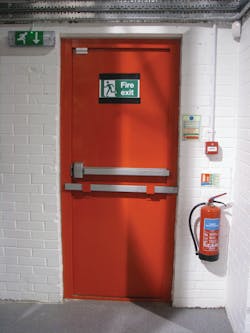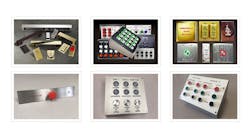When access control hardware is installed on doors in a new or existing building, it’s extremely important to be aware of the fire, life-safety and building codes that impact these applications.
Failure to take these code requirements into account could result in liability for blocked egress routes and fire door assemblies with labels which are null and void.
If electrified hardware is installed without the proper release devices, or in locations where a product is not allowed by code, the cost to rectify the situation can be extensive. Understanding these requirements in advance can help to avoid these problems.
Here’s a look at code requirements for four of the most prevalent access control devices found in a typical building:
Fire Doors
Any product used as part of a fire door assembly must be listed for that use. This includes the access control lock or fire exit hardware, power transfer, door position switch or any other component mounted on the door or frame. One of the requirements for a fire door is that it must be self-latching, so removing a mechanical lockset and replacing it with an electromagnetic lock would not meet the latching requirement. If an electric strike is installed on a fire door assembly, it must be fail-secure so that, upon power failure, the keeper is secure and the door is latched.
The most common issue when installing electrified hardware on an existing fire-rated opening is the limitation on field preparation of fire-rated doors and frames. NFPA 80 is the standard for “Fire Doors and Other Opening Protectives,” which limits field modifications of fire door assemblies to: 3/4-inch wood or composite door undercutting and preparation for surface-applied hardware; function holes for mortise locks; holes for labeled viewers; and protection plates. Round holes may be drilled in the field to accommodate operating components like cylinders, spindles and through-bolts with a maximum hole size of 1-inch, except for cylinder holes which may be any diameter.
Any field modifications beyond what is allowed by NFPA 80 may require that the assembly be re-labeled by the listing agency, which can be very expensive.
Delayed Egress
A delayed egress lock is designed to delay the door from unlocking for 15 seconds and, then, allow free egress. Immediate egress is required upon power failure or fire alarm. A delayed egress lock cannot be installed if a building is not protected by an automatic sprinkler system or approved automatic smoke or heat detection system.
An audible alarm and emergency lighting are required in the vicinity of the door, and signage stating how the delayed egress lock functions must be posted on the door. The 15-second timer must be initiated by a 15-pound maximum force, and the delayed egress lock must be rearmed manually after the release cycle is complete. It must also be able to be released remotely.
The codes vary regarding requirements for delayed egress hardware. The prevalent codes in the United States are the International Building Code (IBC) and NFPA 101, the Life Safety Code. The IBC allows delayed egress locks in all use groups except Assembly, Educational and High Hazard occupancies. NFPA 101 allows delayed egress locks in all low and ordinary hazard occupancies but, in some cases, there are conditions for their use. For example, on assembly occupancies, NFPA 101 allows delayed egress locks on any doors other than the main entrance.
Another difference between codes is the length of time allowed for actuation of the 15-second timer. The IBC requires the timer to start when force is applied for 1 second; while NFPA 101 allows the force to be applied for up to 3 seconds. The IBC also limits delayed egress devices to one delay before entering an exit (for example, a protected stairwell), while this requirement varies by occupancy type per NFPA 101.
It is imperative to know which code is being enforced in the location in order to apply the appropriate requirements.
Electromagnetic Locks
Electromagnetic locks are often used for retrofit access control applications because the installation is relatively easy compared to other electrified locks. Prior to the 2009 editions of the IBC and NFPA 101, the requirements for doors equipped with electromagnetic locks were found in the section of the code called “Access-Controlled Egress Doors.” This section still exists, but a new section has been added — “Electromagnetically Locked Egress Doors” in the IBC, or “Electrically Controlled Egress Door Assemblies” in NFPA 101.
The main difference between the two sets of requirements is that the original section required electromagnetic locks to be released by any of the following:
1. A sensor initiated by an approaching occupant;
2. A marked emergency push button mounted beside the door, which unlocks the door for 30 seconds (independent of the access control system);
3. Actuation of the fire alarm; and
4. Loss of power to the lock.
The new sections allow the electromagnetic lock to be released by a door-mounted release device (i.e. panic hardware, touch-sense bar or latchset with an integral switch), which has an obvious method of operation under all lighting conditions and can be operated with one hand. Loss of power to the switch is required to unlock the electromagnetic lock. If door-mounted hardware is used to release the electromagnetic lock, the release devices are not required.
In the 2012 edition of the IBC, electromagnetic locks may be used on doors with panic hardware as long as actuation of the panic hardware releases the electromagnetic lock. This is a change from the 2009 edition.
Stairwell Re-entry
When door hardware is installed in stairwells to control access from the stair into a tenant space, the requirements for stairwell re-entry must be considered. The purpose of stairwell re-entry is to enable a building occupant to leave the stair if it becomes compromised during a fire and enter the tenant space to seek egress via another stair. Stairwell re-entry also enables firefighter access to the floors. Free egress from the tenant floors to the stairwell must be allowed at all times, except for specific exceptions detailed in the codes.
Codes typically require stair doors to be equipped with fail-safe electrified locks or fail-safe electrified lever trim for fire exit (panic) hardware. These products ensure that the doors can be unlocked automatically upon fire alarm or by a signal from the fire command center and that they remain latched as required for fire doors. The method of release — fire alarm or signal from fire command center — varies depending on which code is being used. A fail safe electric strike is not an option for stairwell re-entry, because electric strikes installed on fire doors must be fail-secure.
The 2003 edition of the IBC allows stairs serving four stories or less to have mechanical locks on the stair side. No remote or automatic release was required for these doors; however, the more recent editions of the IBC require fail-safe locks with remote release, even for stairs serving 4 stories or less. For stairs in high-rise buildings where stair doors are locked electrically, the IBC requires a telephone or two-way communication at every fifth floor, which is connected to a constantly attended station.
NFPA 101 does allow stair doors serving four stories or less to have mechanical locks, and it also allows “selected re-entry,” where some doors are locked and others are unlocked to allow re-entry.
The Life Safety Code details which doors need to be unlocked per the selected re-entry requirements — the top or next-to-the-top story (and that story must allow access to another exit); a maximum of four locked floors between unlocked floors; and a minimum of two unlocked floors per stairwell. The exit discharge — typically at ground level, would allow free egress at all times. Signage is required at each level inside of the stairwell, directing building occupants to the unlocked floors.
Plan Ahead
Before installing access control hardware, ensure that your proposed products are acceptable for the applicable use group and that all code requirements are met. Doors with access control must not obstruct egress routes or negatively impact fire barriers. As a general rule of thumb, free egress is required at all times, not just upon fire alarm — although there are some exceptions, particularly in healthcare.
Informed application of access control hardware will protect life safety, ensure the effectiveness of fire doors, reduce liability and prevent costly replacement of non-compliant material.
Lori Greene, AHC/CDR, CCPR, FDAI, is Ingersoll Rand Security Technologies manager of codes and resources. Visit her blog at www.iDigHardware.com. Visit www.securityinfowatch.com/10215684 for more information.


